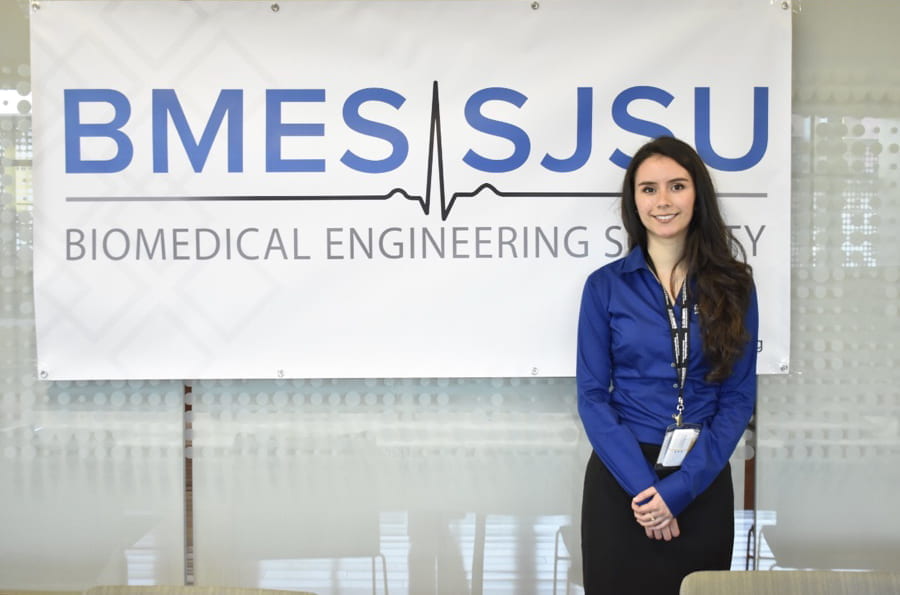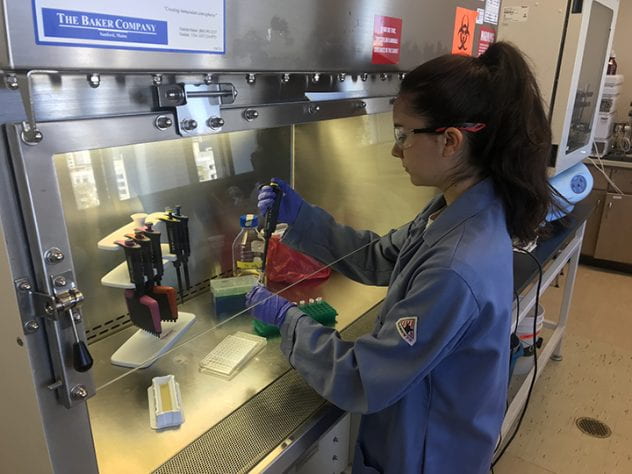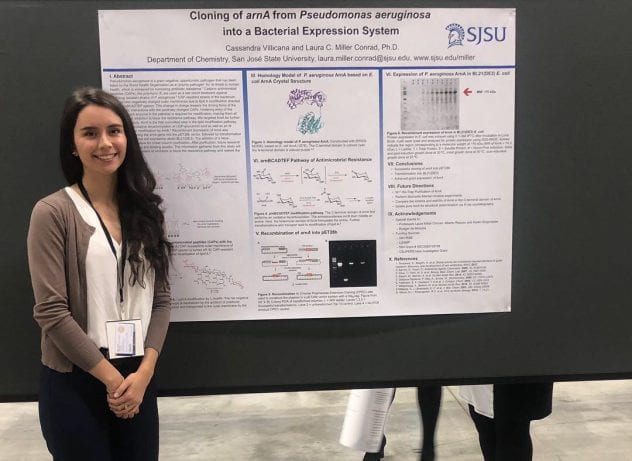
Cassandra Villicana, ’19 Biomedical Engineering, poses for a photo at a Biomedical Engineering Society of SJSU event.
By Abby McConnell, Office of Research
Cassandra Villicana, ’19 Biomedical Engineering, didn’t speak English before she enrolled in kindergarten in East San Jose, but by the time she started first grade, she was bilingual and doing math at a 4th grade level. Her parents, who emigrated from Mexico, emphasized the value of education to all of their children from a very young age. When Villicana’s brothers were in elementary school, her parents enrolled in an adult school to learn English, and when Villicana was born, they made sure their daughter had a head start when it came to numbers.

Cassandra Villicana has been involved in interdisciplinary research in a biochemistry lab at SJSU as well as other research projects.
“Although my father did not receive any formal education and my mother only attended primary school, they knew core math concepts that they wanted me to understand. I remember sitting at the kitchen table after school and doing my times tables and learning long division with my mom, while my father took out card games and dominoes to help me understand statistics,” she said.
Villicana is one of two SJSU students who has been awarded a National Science Foundation Graduate Research Fellowship (GRFP). The NSF received more than 12,000 applicants in 2018 and made 2,000 offers nationwide.
The GRFP is the oldest graduate fellowship of its kind, and recognizes outstanding graduate students in NSF-supported science, technology, engineering, and mathematics disciplines who are pursuing research-based master’s and doctoral degrees. NSF Fellows often become knowledge experts who contribute significantly to research, teaching, and innovations in science and engineering.
From Multiplication to MESA
While Villacana’s early talent for math might have been a sign of her future in STEM, she said she didn’t fall in love with science until she was a freshman at Mt. Pleasant High School in East San Jose. There, she discovered the Mathematics Engineering Science Achievement Program (MESA), an organization that fosters early interest in math and science and prepares California middle and high school students to successfully pursue STEM majors in college.
Her first MESA competition introduced her to biomedical engineering and inadvertently, San Jose State. Her team was tasked with building and presenting a prosthetic arm for the National Engineering Competition, and regionals were held on SJSU’s campus. Villicana has been hooked on the possibilities of science and engineering ever since.
“It was the real world application of science and math concepts that I loved, especially the ability to translate that into an actual device that could help people. That transfer of knowledge was incredibly powerful to me,” Villicana said.
Research and Outreach

Cassandra Villicana presented her research at the Annual Biomedical Research Conference for Minority Students.
Helping others and transferring knowledge The values of transferring knowledge and helping people speak to the core of who Villicana is, both personally and academically. Through MESA in high school, she mentored younger students in STEM activities, and once at SJSU, through the college-level MESA Engineering Program (MEP) she continued that work. In her undergraduate career she has supported educational outreach to local schools, coordinated corporate sponsors for the Science Extravaganza and judged the MESA Engineering Design Competition. She also managed to earn the title of “Youngest Hired Chemistry Workshop Instructor” by running a support class for fellow undergraduates to help them pass one of the most failed courses on campus.
“As an engineering student, while service and outreach may be on your to-do list, it takes effort and focus to find the time to give back,” said Blanca Sanchez-Cruz, assistant director of Student Support Programs in the College of Engineering. “As Cassandra has moved forward academically and professionally, her priorities have remained linked to the local community. While she has always possessed a clear vision of what she wants to achieve, her priority is building bridges to student whose backgrounds are similar to her own, so they can see a path to college and careers in STEM.”
Villicana has been involved in a range of research activities, from collaborating on a real-time heart rate monitor prototype at Chung Yuan Christian University in Taiwan through the Global Technology Institute Program at SJSU to laser development at Boston Scientific Corporation, researching ways of destroying kidney stones and prostate scar tissue without invasive surgery. For the past two years, she has conducted research in Dr. Laura Miller Conrad’s biochemistry lab, working to reverse the effectiveness of antibiotic-resistant pathogens from the inside-out, by blocking the pathways that make them immune to some of the world’s most commonly used antibiotics.
Taking the Next Step
This research was at the core of Villicana’s proposal for the NSF fellowship, and she also incorporated her interest in microfluidic device design.
After gaining admission to twelve graduate programs, Villicana decided to take her NSF support with her to Stanford in the fall. Choosing Stanford had much to do with the sense of community she experienced during her campus visit, which felt very similar to the one she was a part of at SJSU. She acknowledges it will be challenging to leave behind supportive professors and advisors, including Dr. Karen Singmaster, Susan Arias, MESA Program Director at SJSU, Miller-Conrad and Sanchez-Cruz, not to mention peers and friends from programs like the Research Initiative for Scientific Enhancement (RISE), Louis Stokes Alliance for Minority Participation (LSAMP) and MEP.
“At least at Stanford, I won’t be far,” Villicana said. “For me, it’s a huge bonus that I can stay local. I love the idea of being able to come back to SJSU and support the organizations that helped me, while using my experiences to show underrepresented students what is possible.”
